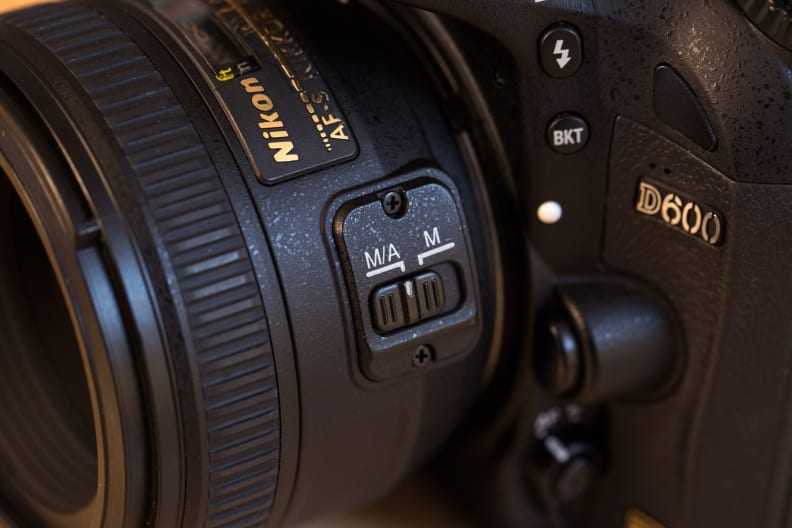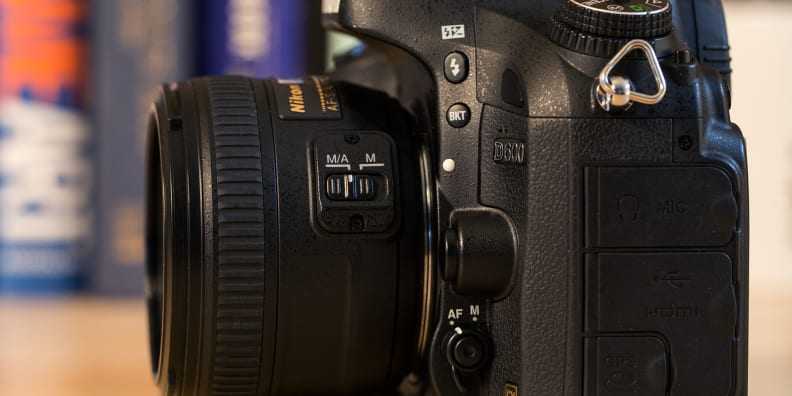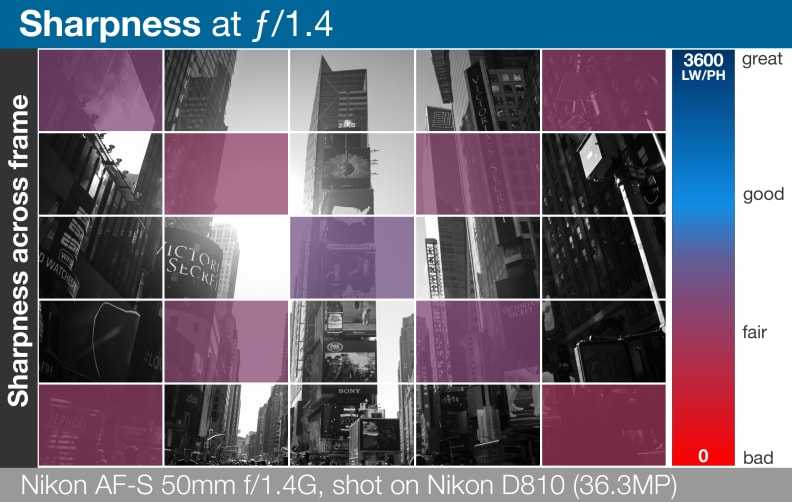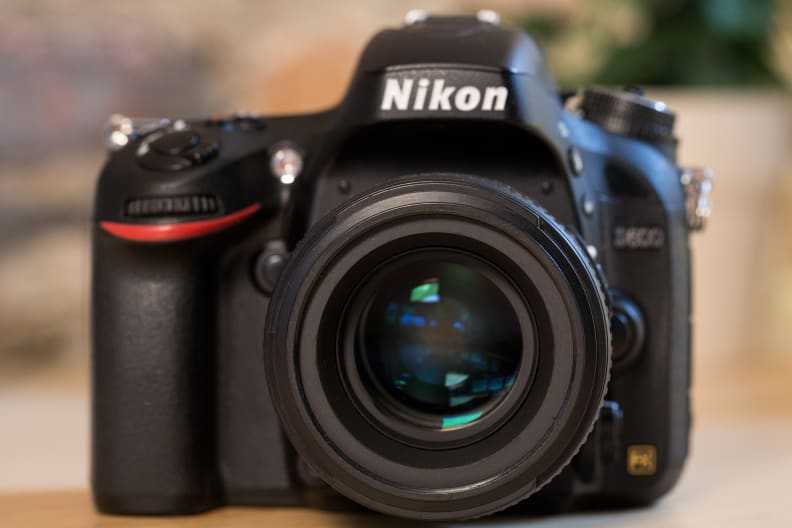Studio Tests — FX format
The Nikon AF-S Nikkor 50mm 1:1.4G comes into its own on its native FX format. Sharpness is notably even right across the image even at F1.4, with the corners better than any other full-frame 50mm we’ve tested. The improvement over the AF-Nikkor 50mm F1.4D is dramatic, especially in terms of corner performance at larger apertures (although it’s important to bear in mind that we tested the older lens on the lower-resolution D3); and while the Sigma 50mm F1.4 EX DC HSM is better in the centre wide open, its advantage disappears on stopping down to just F1.8.
| Sharpness | Sharpness is good right across the frame wide open, with the centre improving rapidly on stopping down and the corners not too far behind. Optimum apertures are around F5.6 to F8, at which point the lens is delivering impressive results right across the frame. |
|---|---|
| Chromatic Aberration | Lateral CA is extremely low, with almost no visible fringing. As on DX, the measured CA in the centre of the frame at F1.4 reveals a degree of color-specific spherical aberration, but rather lower than the old ‘D’ lens |
| Falloff | We consider falloff to become perceptible when the corner illumination falls to more than 1 stop less than the centre. Falloff is slightly better than average for its class on full frame at 2.3 stops wide open, falling to 1 stop on stopping down to F2.8; this may be annoying to users brought up on smaller formats. |
| Distortion | Distortion on full frame is a little lower than the older ‘D’ lens at about 1% barrel; just about enough that it might sometimes be visible in real-world shots. |
FX compared to DX
Eagle-eyed viewers will no doubt have noticed that the MTF50 sharpness data at any particular focal length/aperture combination is distinctly higher on FX when compared to DX. This may at first sight appear unexpected, but in fact is an inevitable consequence of our presentation of the sharpness data in terms of line pairs per picture height (and thus independent of format size).
Quite simply, at any given focal length and aperture, the lens will have a fixed MTF50 profile when expressed in terms of line pairs per millimeter. In order to convert to lp/ph, we have to multiply by the sensor height (in mm); as the full-frame sensor is 1.5x larger, MTF50 should therefore be 1.5x higher.
In practice this is an oversimplification; our tests measure system MTF rather than purely lens MTF, and at higher frequencies the camera’s anti-aliasing filter will have a significant effect in attenuating the measured MTF50. In addition, our testing procedure involves shooting a chart of fixed size, which therefore requires a closer shooting distance on full frame, and this will also have some influence on the MTF50 data.
Macro Focus
| The 50mm behaves similarly in our macro test on full frame as on DX. Naturally the close focus, working distances and magnification figures remain the same as on DX at 43.5cm, 34cm, and 0.16x respectively.Again results aren’t great wide open, but the centre sharpens up well on stopping down to F4, and by F8 the corners are looking very sharp too. Barrel distortion is quite visible, and red/cyan chromatic aberration quite visible. | |
|
Macro — 237 x 158 mm coverage Distortion: Moderate barrel Corner softness: Moderate Focal length: 50mm |
|---|
Примеры фотографий на Nikon 50mm f/1.8D AF
Самое серьезное испытание для любого нормального объектива — это фотосъемка на максимально открытой диафрагме. Как видно в представленных примерах, даже на диафрагме 1.8 объектив Nikon 50mm f/1.8D AF имеет прекрасные изобразительные качества.
При фотосъемке всех фото использовалась фотокамера Никон Д700.
Детские фотопортреты
Диафрагма 1.8Яркое портретное фото девочки осенью в лучах солнца из галереи
Диафрагма 1.8Осенний фотопортрет девочки из галереи
Примеры фотографий: свадебные фотопортреты и натюрморты
Диафрагма 1.8Фотопортрет девушки с избирательной резкостью на глазах из галереи
Диафрагма 1.8Фотопортрет девушки из галереи
Диафрагма 1.8Свадебный фотопортрет невесты из галереи свадьбы в усадьбе Архангельское в Московской области
Диафрагма 1.8
Фотопортрет невесты из галереи свадьбы в усадьбе Архангельское в Московской области
Диафрагма 1.8Свадебный фотопортрет невесты из галереи летней свадьбы в Королёве
Диафрагма 1.8Свадебная фотография жениха и невесты из галереи
Диафрагма 1.8Свадебный натюрморт с цветами из галереи летней свадьбы в Королёве
Диафрагма 1.8Свадебный натюрморт на морскую тематику из галереи свадьбы в «Малибу», Пирогово
Примеры мужских фотопортретов
Диафрагма 1.8
Диафрагма 2.8Фотопортрет юноши для мужского портфолио из галереи студийной фотосъемки мужских фотопортретов
В контровом свете на диафрагме f/1.8 не очень контрастный
Диафрагма 1.8
В контровом свете на максимально открытой диафрагме объектив Nikon 50mm f/1.8D не очень контрастный.Фото влюбленной пары из фотосессии лав-стори в московском Ботаническом саду МГУ
Фотопортреты девушки ночью с уличным светом
Все ночные фотопортреты девушки, представленные ниже, сделаны на максимально открытой диафрагме 1.8, так как ночью освещенность очень низкая, и уличного света для портретной фотосъемки всегда не хватает.
Диафрагма 1.8Фотопортрет девушки ночью в свете ночных огней из галереи с фотографиями девушки на улицах города
Диафрагма 1.8Фотопортрет девушки ночью в свете ночных огней из галереи с фотографиями девушки на улицах города
Диафрагма 1.8Фотопортрет девушки ночью в свете ночных огней из галереи с фотографиями девушки на улицах города
Диафрагма 1.8Фотопортрет девушки ночью в свете ночных огней из галереи с фотографиями девушки на улицах города
Диафрагма 1.8Фотопортрет девушки ночью в свете ночных огней из галереи с фотографиями девушки на улицах города
Диафрагма 1.8Фотопортрет девушки ночью в свете ночных огней из галереи с фотографиями девушки на улицах города
Chromatic Aberration
Chromatic aberration refers to the various types of “fringing” that can appear around high contrast subjects in photos—like leaves set against a bright sky. The fringing is usually either green, blue, or magenta and while it’s relatively easy to remove the offensive color with software, it can also degrade image sharpness.
While there’s some chromatic aberration evident in our test shots, it’s well-corrected compared to some other fast primes and certainly within normal tolerances. Color fringing is most visible near the corners, especially at f/1.4 and f/2, but it’s easily correctable with some minor post-production work.
Image Quality
In our imaging lab, the Nikon AF-S 50mm f/1.4G impressed us with sharp results at f/1.4 that just continued to get better as we stopped the aperture down—all the way to f/16. When it’s paired with a high resolution sensor like the one in the Nikon D810, you can tease excellent results from this lens in all kinds of conditions.
 Credit:
Credit:
Reviewed.com / Kyle Looney
EXIF: 50mm, ISO 200, 1/8000, f/1.4
Sure, it’s a tad softer wide open than the best f/1.4 lenses we’ve tested, and the cheaper Nikon 50mm f/1.8G is a tad sharper in places, there’s one crucial dimension where the f/1.4 jumps ahead: bokeh.
The out-of-focus areas you can get from the 50mm f/1.4 and its nine-bladed aperture are incredibly smooth, with hardly any defects to spoil the washes of color and lovely, rounded points of light. There’s a bit of coma (oval-shaped bokeh) toward the edges of the frame wide open, and it takes on a very slightly squared-off look as you stop down, but on the whole this lens does a stellar job.
 Credit:
Credit:
Reviewed.com / Kyle Looney
EXIF: 50mm, ISO 200, 1/160, f/10
There’s more good news, too: Chromatic aberrations (colored fringing) and geometric distortion (bent lines) are minimal, so you won’t need to do much work to post-process files from this lens. There may be slightly sharper f/1.4 lenses out there, but this lens could easily serve as your go-to glass the majority of the time.
Below you can see sample photos taken with the AF-S Nikkor 50mm f/1.4G mounted on a Nikon D810. Click the link below each photo to download the full-resolution image.
{{ photo_gallery name=»sample» }}
Look and Feel
The AF-S 50mm f/1.4G, like most of Nikon’s newer G-series lenses, has a pretty straightforward physical design. Unlike the classic 50mm f/1.4D, the “G» version has no aperture ring, is made primarily of plastic, and includes a built-in Silent Wave Motor (SWM) for quick, quiet focusing.
 Credit:
Credit:
Reviewed.com / Chris Thomas
Like other G-series primes, the 50mm f/1.4 includes a M/A mode that lets you override the autofocus motor with manual adjustments.
Like many other pro-oriented primes, this one doesn’t rotate or extend when focusing, which is a plus when using filters like circular polarizers. It also features a manual focus override switch, letting you use autofocus while still making manual adjustments whenever you want. It’s a feature that’s especially useful when you’re working up close at wide apertures, where even slight movements can dramatically change the point of focus.
 Credit:
Credit:
Reviewed.com / Chris Thomas
The small focus ring is clearly an afterthought—not a surprise in the age of autofocus.
In terms of feel, the lens is a bit more luxurious than the «D» version it replaced. The focus ring turns more smoothly (though it’s focus-by-wire), and though it lacks the hard stops of the previous generation there’s feedback to let you know when you’ve hit the limits of the focus range. The throw is short, but it’s tuned tightly enough that even small changes are easy enough to make.
Though we have to confess we have a soft spot for old-school metal lenses with aperture rings, Nikon clearly believes in the simplified «G» design. Ultimately, there’s not much to complain about here given the sub-$500 price.
{{ photo_gallery name=»tour» }}
Focus and build quality
Focus accuracy and repeatability is critical to consistently produce sharp shots, especially with large aperture primes. Repeatability (the accuracy of focus on the same subject after repeated focus-acquisition) of this lens is very good with only very slight variations and no real outlier over a series of 40 shots. And the lens focuses in around 0.7 sec from infinity to 60 cm, which is OK. The Sigma 50/1.4 does this in 0.5 sec.
The focus ring has no slack/play between its movement and the focus-action and a throw of around 190 degrees, which is very convenient for accurate manual focus wide open (the Sigma 50/1.4 turns only 90 degrees). The focus ring is a bit small with a 0.9 cm wide profiled rubber surface but it is still easy enough to grip and moves smoothly. AF-operation is pretty quiet from the outside. If you record video with the built-in microphone focus-movement starts and stops with the typical “clack” but the AF-drive itself is not too annoying. Focus breathing is visible: things in the background become larger the closer you focus. But I’d rate the effect pretty harmless.
The lens needed some micro AF adjustment for optimal AF on my D300. The adjustment varied with the distance from the subject: Close-up to the test-chart at 60cm the optimum Micro AF-adjustment was -15, but at 1m it was -5, and finally at 1.8m it was around zero. This also turned out to be the optimum (non-)adjustment for further-away subjects, such as those at 20m. The need for micro AF adjustment typically depends on the body(-type). So be aware that this lens (and other large aperture primes) may need different adjustments depending on shooting distance. Go for the adjustment which best matches your typical shooting distance with this lens.
Focusing in very low-light with this lens can be pretty amazing: I was able to nail focus under conditions that required 2 sec exposures at f1.4 and 200 ISO on a D300. This is pretty dark, and the focus didn’t even hunt or stutter.
The lens has a weather sealed metal lens-mount and nine rounded aperture blades. The outer barrel is plastic. It’s pretty easy to produce kinks in the front-disk directly behind the filter-thread by simply re-attaching the lens-cap without caution. But this is only cosmetic and does not influence the optical performance.
Now it’s time to check out some results in my Nikon 50mm f1.4 quality and Nikon 50mm f1.4 sample images pages!
Motivation
The 50mm focal length is considered a “normal”-lens on a full-frame camera-body. Lenses are called “normal” when their focal length is close to the diagonal of the sensor (43mm for a FX-sensor). These lenses produce a life-like perspective and natural look when the images are also viewed from a distance that is equivalent to the diagonal of the print/monitor. But mind you: it is not long enough for a flattering perspective in tight head-shots on an FX body. Framing a 60 x 40 cm portrait requires you to go as close as 0.8m which is generally considered too close. For that type of shot you better get a 85mm lens for your FX body. Of course when you mount it on a DX body it delivers a much more portrait-friendly 75mm equivalent.
50mm is also the focal length that lets you get the much coveted f1.4 aperture for a full-frame body with auto-focus at a much lower price than at other focal lengths like 35mm or 85mm. So if you chose only one f1.4 lens for your work this is the affordable alternative. And at f1.4 the lens gives you two-thirds of a stop more light-gathering power than comparable f1.8 lenses and produces a larger blur-circle all of which comes in handy if you’re shooting under low(er) light or try to better isolate your subject from the background.
Sharpness
A lens’s sharpness is its ability to render the finest details in photographs. In testing a lens, we consider sharpness across the entire frame, from the center of your images out to the extreme corners, using an average that gives extra weight to center performance. We quantify sharpness using line widths per picture height (LW/PH) at a contrast of MTF50.
 Credit:
Credit:
Reviewed.com / Chris Thomas
Stopped down to f/8, pictures are commendably sharp.
The Nikon 50mm f/1.4G has a typical performance profile for a fast prime lens. As tested on a Nikon D810 in our labs, at f/1.4 it’s sharp in the center of the frame (resolving around 1,500 lines) but softer (around 1,000 lines) in the corners. Compared to many prime lenses mounted on a D810, those results aren’t stellar, but they’re good enough.
 Credit:
Credit:
Reviewed.com / Chris Thomas
At full wide, this lens is a bit lacking.
As you stop down the aperture, center performance steps up considerably, peaking at 2,450 lines at f/8. The corners also improve dramatically as soon as you move past f/1.8, topping out at well over 2,000 lines around f/8. Even at f/16, the performance is remarkably good—2,000 lines across the frame. That makes this lens an excellent choice for landscapes and product photography, as even the smallest details will be accurately rendered.
Help Me Help You top
I support my growing family through this website, as crazy as it might seem.
The biggest help is when you use any of when you get anything. It costs you nothing, and is this site’s, and thus my family’s, biggest source of support. These places always have the best prices and service, which is why I’ve used them since before this website existed. I recommend them all personally.
If you find this page as helpful as a book you might have had to buy or a workshop you may have had to take, feel free to help me continue helping everyone.
If you’ve gotten your gear through one of my or helped otherwise, you’re family. It’s great people like you who allow me to keep adding to this site full-time. Thanks!
If you haven’t helped yet, please do, and consider helping me with a gift of $5.00.
As this page is copyrighted and formally registered, it is unlawful to make copies, especially in the form of printouts for personal use. If you wish to make a printout for personal use, you are granted one-time permission only if you PayPal me $5.00 per printout or part thereof. Thank you!
Ken.
Home Donate New Search Gallery Reviews How‑To Books Links Workshops About Contact
Reasons to Buy Nikon AF-S Nikkor 50mm f1.4G Lens
Here we’ve included a summary of the advantages and disadvantages of the Nikon AF-S Nikkor 50mm f1.4G lens in a list form to help you determine whether it offers the features you need.
PROs
| Autofocus |
| Distance Scale |
| DoF(Depth of Field) Scale |
| Hood supplied |
| Full-time Manual Focusing |
| Very Fast Aperture |
| Covers Full-Frame Sensor |
| 9 Diaphragm Blades for Smooth Bokeh |
Report a correction
Buy Nikon 50mm f1.4G from or B&H PHOTO
CONs
| No Weather Sealing |
Lens Mount
Nikon 50mm f1.4G is compatible with cameras that have a Nikon F (FX) lens mount. Some of the latest released cameras that are compatible with the Nikon F (FX) lenses are Nikon D6, Nikon D780 and Nikon D3500.
Size, Weight and Filter Thread
Size and weight is a very important decision factor when searching for your next lens. Nikon 50mm f1.4G has a maximum diameter of 74mm and total length of 54mm. It weighs 290g / 10.2 oz.
Nikon 50mm f1.4G has a filter thread of 58mm. Below are links to the filters that we recommend you to consider for your Nikon 50mm f1.4G:
Optical Image Stabilization
Nikon 50mm f1.4G doesn’t have an optical image stabilization system so the only option to stabilize the image taken with this lens is to mount on a camera body with IBIS (sensor based In-body image stabilization).
Alternatively, you can check the Tamron 45mm F1.8 Di VC USD in Nikon F (FX) mount that have similar focal range but features Optical Image Stabilization.
Lenses Similar to Nikon 50mm f1.4G With Optical Image Stabilization
| Model | Coverage | Weight | Focusing | Street Price | |
|---|---|---|---|---|---|
|
Tamron SP 45mm F1.8 Di VC USD Compare |
35mm FF | 520gr | AF |
Maximum Magnification Ratio
Nikon 50mm f1.4G has a Max Magnification Ratio of 0.15x and has a minimum focusing distance of 0.45m. 0.15x means that the max magnification ratio is very low and not suitable even for modest close-up shots.
Below are the 3 Standard Prime type Nikon F mount lens alternatives with highest max magnification ratios:
- Tamron 45mm F1.8 Di VC USD: 0.3x — (Compare)
- Sigma 50mm F1.4 DG HSM A: 0.18x — (Compare)
- Nikon 35mm f1.8G: 0.16x — (Compare)
Lens Hood
Nikon 50mm f1.4G comes with a removable lens hood which is handy to reduce lens flare and glare in your photos. The model number of the hood is HB-47.
Popular Comparisons of Nikon 50mm f1.4G
Top Alternatives of Nikon 50mm f1.4G Lens
| Model | Coverage | Weight | Focusing | Street Price | |
|---|---|---|---|---|---|
|
Sigma 50mm F1.4 EX DG HSM Compare |
35mm FF | 505 g / 1.11 lb | AF | ||
|
Nikon AF Nikkor 50mm f1.4D Compare |
35mm FF | 230 g / 0.51 lb | AF | ||
|
Nikon AF-S Nikkor 50mm f1.8G Compare |
35mm FF | 185 g / 0.41 lb | AF | ||
|
Nikon AF-S Nikkor 50mm f1.8G Special Edition Compare |
35mm FF | 185 g / 0.41 lb | AF | ||
|
Tamron SP 45mm F1.8 Di VC USD Compare |
35mm FF | 520 g / 1.14 lb | AF | ||
|
Sigma 50mm F1.4 DG HSM A Compare |
35mm FF | 815 g / 1.79 lb | AF | ||
|
Voigtlander 58mm F1.4 Nokton SL II Compare |
35mm FF | 320 g / 0.70 lb | MF | ||
|
Nikon AF-S Nikkor 58mm f1.4G Compare |
35mm FF | 385 g / 0.85 lb | AF |
Distortion
We penalize lenses for distortion when they bend or warp images, causing normally straight lines to curve.
There are two primary types of distortion: When the center of the frame seems to bulge outward toward you, that’s barrel distortion. It’s typically a result of the challenges inherent in designing wide-angle lenses. When the center of the image looks like it’s being sucked in, that’s pincushion distortion. Pincushion is more common in telephoto lenses. A third, less common variety (mustache distortion) produces wavy lines.
As we’d expect from a 50mm «normal» prime lens, the AF-S 50mm f/1.4G handles geometric distortion well. In our labs, we saw about 1.55% barrel distortion—actually a little more than we typically see in this class, but well within acceptable bounds and easily correctable with photo editing software.
Как снимать групповой портрет 50 мм объективом
Основная ошибка при съемке группового или парного портрета заключается в открытой диафрагме.
Начинающие широко распахивают диафрагму ради размытого фона, не подозревая, что глубины резкости на всех портретируемых не хватит.
Кто-то из участников съемки неминуемо вывалиться из глубины резкости и будет в расфокусе.
Исключение возможно только в том случае, когда вы расставите всех участников в фокальной плоскости объектива по линеечке, выдержав расстояние между объективом и всеми участниками одинаковым.
При съемке парного портрета на широко открытой диафрагме в стиле «мужчина выглядывает из-за плеча женщины, обнимая ее», второй участник съемки всегда будет вне резкости.
Аналогично со стилем «мама с малышом на руках».
Можно ли исправить ситуацию?
Глубина резкости зависит не только от фокусного расстояния, что в случае 50 мм объектива составляет 50 мм, но и расстояния до объекта съемки и диафрагмы.
Чем дальше вы отойдете от модели и чем большую диафрагму установите, тем большую глубину резкости вы получите.
Можно широко открыть диафрагму и отойти подальше от пары. Это поможет предотвратить выпадение из фокуса второго человека.
Вопрос в другом.
Будет ли возможность отойти и что делать с получившимся ростовым или поясным портретом, когда хотелось снять погрудный.
В play market и appstore можно найти множество приложений, что рассчитывают глубину резкости для конкретных объективов и диафрагм.
Приложения полезны тем, что наглядно видно, насколько узкую полоску резкости вы можете получить.
И будет легко понять, укладывается ли мама с малышом в эту полоску резко изображаемого пространства или нет.
Парные и групповые портреты можно снимать на 50 мм объектив.
Достаточно подобрать ту глубину резкости, что будет охватывать всех участников съемки, рассчитав диафрагму и расстояние до объекта съемки.
Лицевые портреты лучше не снимать на 50 мм объектив. При необходимости крупного плана сделайте кроп кадра от поясного портрета.
Этому есть свое объяснение, и оно достойно отдельной большой статьи.
Источник
Тема: АФ полтинники на никон
Автор реплики: akalashnikoff
АФ полтинники на никон
по следамhttp://community.livejournal.com/ru_d70/1837154.html
и последующегоhttp://community.livejournal.com/ru_d70/1916044.html.
В результате у меня скопилось 3 испытуемых:
AF Sigma 50 mm/f1.4 EX DG HSM for Nikon
AF-s Nikkor 50 mm/f1.4 G
AF Nikkor 50 mm/f1.4 D
По скорости на д3 сигма не отстает, или чуть быстрее отверточного никкора, новый же AF-s позади планеты всей. Тормоз, одним словом.
Из заметных отличий:
— у никкоров значительно сильнее выражено виньетирование на открытой диафрагме;
— у сигмы визуально немного меньше ФР (тестовые снимки сделаны плюс-минус с одной точки);
— экспозамер с сигмой делает картинку светлее приблизительно на 0,3 EV (я ставил коррекцию);
— мой экземпляр сигмы таки потребовал коррекции АФ в -5 на обех тушках.
Заниматься тестирование резкости (она сопоставима) и геометрии (фотозона на что?)
я не стал, а просто сделал несколько тестовых картинок. Во всей серии сортировка идет
по сюжету/диафрагме/объективу. Под картинкой подписано чем снято. У больших сохранен эксиф.http://www.kalashnikoff.net/public/50mm_af/
UPD по камментам.
Сигма помягче в бокэ, чем оба никкора. Особенно на прикрытых дырках и пестрых сюжетах.
Опять же Сигма лучше держит контровый свет. Конечно, судить по одному примеру не очень и стоит проверить еще.
Оба никкора лучше передают объем, хотя я сам с трудом понимаю, как это объяснить. Ну и источники света о моторного никкора и сигмы круглые ).
Старый и новый никкоры практически неотличимы на открытой диафрагме.
Резкость вне фотоонанистических тестов — сопоставимая и достаточная.
Чуда не случилось. На большинстве сюжетов (ну кроме пестроты и источников света в бокэ) разница между рисунком трех стекляшек косметическая и не стоит внимания.
На мой взгляд, выбирать полтинник из этой троицы следует по критериям, не связанным с рисунком.
Я выбрал Сигму, исходя из того, что она быстрая, с мотором (бесшумная), имеет скругленную диафрагму и человеческую бленду.
Объективы Nikon с фиксированным фокусным расстоянием имеют приятную избирательную резкость
В последнее время я часто использую именно Nikon 50mm f/1.8D AF. Должен признаться, что в начале своей творческой карьеры я не придавал особого значения использованию объективов Nikon с фиксированным фокусным расстоянием и, в частности, этому объективу Nikon 50mm f/1.8D AF, снимая фотосессии от начала и до конца бюджетными зумами (ну то есть zoom — зум-объективами). И примерно с 2010 года, когда поступил заказ на свадебную фотосъемку, жених и невеста в которой сделали мне акцент на фотографиях с избирательной резкостью, я ощутил все превосходство этого фиксфокала Nikon. И это касается как безупречной резкости на главном объекте съемки, так и красивого боке за пределами глубины резкости изображаемого пространства.
Samples Gallery
There are 30 images in the samples gallery. Please do
not reproduce any of these images on a website or any newsletter / magazine
without prior permission (see our copyright
page). We make the originals available for private users to download
to their own machines for personal examination or printing (in conjunction
with this review), we do so in good faith, please don’t abuse it.
Unless otherwise noted images taken with no particular
settings at full resolution. To provide the fairest impression of the lens itself, images are shot in RAW and converted using Adobe Camera Raw at default settings (to bypass the test cameras’ automatic JPEG chromatic aberration correction). A reduced size image (within 1024 x 1024
bounds) is provided to be more easily viewed in your browser. As always
the original untouched image is available by clicking on this reduced
image.
Nikon AF-S Nikkor 50mm f/1.4G Performance
The Nikon AF-S Nikkor 50mm f/1.4G lens’ performance is excellent for a standard len’s type. It’s sharpness is quite good at f/1.4, center to edge regions are nice and clear, with low chromatic aberration & vignetting results. This camera lens performs very well across aperture settings, but there is some softness in the corners when it’s used wide open at F 1.4 – this makes sense considering that it’s design is to have an attractive smooth blurred background compared to bokeh tend to be pretty harsh or not great at all on lenses with circular aperture blades because of their nature.
Build and Handling Quality
The lens barrel construction is very solid and sturdy with metal (aluminum alloy) used for much of it’s exterior shell, but a little ‘light’ feeling when compared to Nikon’s other pro-level lenses.. The focus ring has a nice rubber grip surface and turns smoothly, but there are no hard stops at either end of the focus range which can make achieving critical focus a bit more difficult as you turn through the whole range before reaching infinity or minimum focusing distance.
Autofocus Performance
The new built-in Silent Wave autofocus motor in the 50mm F1.4G, as compared to its predecessor, improves accuracy and consistency. However, it does have slower autofocus compared to that of its predecessors, which is a huge disadvantage because it’s considered the slowest out of all the Nikon 50mm lenses in terms of autofocus.
Having said that, its AF motor makes it nearly silent, which is an advantage and can make up for the slowness you’d otherwise experience.
Sharpness
The lens is incredibly sharp when fully opened up. When the aperture is stopped down, however, the image quality improves dramatically. Across the frame, performance is extremely consistent, with only minor fluctuations in contrast. Between F5.6 and F8 (or equivalently between F22 and F32), you’ll get fantastic clarity throughout the frame.
Vignetting
Vignetting is especially visible when the lens is wide open at F1.4, and to a lesser extent in lower light conditions and when used with an APS-C DSLR. On the other hand, the D700 sensor has quite good coverage so stopping down resolves much of this issue.
Chromatic Aberration
The Nikon AF-S Nikkor 50mm f/1.4G is very resistant to chromatic aberration, so much so that the lens has excellent performance at either end of its aperture range, even wide open.
Distortion
There is a moderate amount of distortion, and stopping down resolves this problem. You can also leverage photo editing tools like Lightroom to take care of distortion in a single click, making this touch point moot.
Image Quality
There is little chromatic aberration or distortion. Vignetting, which is especially visible at F1.4, is also highly resistant to stopping down.
Sharpness and contrast are excellent across the frame even when wide open, and improve as you stop down. Wide open performance is very good in the center of the frame but gradually diminishes towards the edges until F5.6, where it’s ‘acceptable’. Between F5.6 and F8 (or equivalently between F22 and F32), performance is amazing throughout the frame with only minor fluctuations in contrast and bokeh quality.
Bokeh
Bokeh is reasonably smooth wide open, with only minor hints of color fringing. When stopped down to F5.6 bokeh is excellent even in the corners.
Handling
The Nikon AF-S Nikkor 50mm f/1.4G is solidly built and features a very well dampened focus ring. Most of the weight is near the front, so it’s easy to balance on a Nikon DSLR like Nikon D300 or Nikon D700. The lens doesn’t come with any kind of hood or filter, but this is increasingly common for mid-range lenses these days.
Conclusion
You can’t judge a book by its cover, but you can judge a lens system by the quality of its «fast fifty» prime lens. If your system’s lens designers can’t nail this one? Good luck producing top-notch lenses with more complex designs.
Though we’re smitten with the (larger, heavier, more expensive) Sigma 50mm f/1.4 Art, this Nikon AF-S 50mm f/1.4G is a very good choice. It’s got superb corner to corner sharpness at even very small apertures, excellent bokeh, and a no-nonsense design and build. Best of all, its sub-$500 price point makes it accessible even to beginners, even if many will still opt for the cheaper 50mm f/1.8G.
 Credit:
Credit:
Reviewed.com / Chris Thomas
The AF-S 50mm f/1.4G offers spectacular bokeh and edge-to-edge sharpness that make it a must-have for all Nikon shooters.
The 50mm focal length is the closest any prime gets to being a generalist, which means it’s not fine-tuned to excel at any one kind of photography. If you have more specific needs, you may want to opt for something more specialized: the 85mm f/1.8G for portraits, the 12-24mm f/2.8 for landscapes and architecture, etc.
There’s a reason even seasoned pros keep a 50mm lens in their bag.
But there’s really no end to what you can accomplish with a 50mm lens like this. It asks you to make fewer compromises than nearly any other focal length, and plenty of photographers have done their best work with a 50mm. Simply put, there’s a reason even seasoned pros keep a 50mm lens in their bag—you never know when it’ll come in handy.
It might not be quite as affordable (or as sharp wide open) as the f/1.8G, but it offers superior bokeh and is just as sharp stopped down. And compared to the king’s ransom you’d have to pay to get a 35mm f/1.4 lens from Nikon, $485 feels like a bargain. No matter what Nikon DSLR you’re shooting with, this lens should be one of the first you pick up.
When evaluating any lens, we focus on four key areas: sharpness, distortion, chromatic aberration, and bokeh. A perfect lens would render the finest details accurately, wouldn’t distort straight lines or produce ugly fringing around high-contrast subjects, and would create smooth out-of-focus areas.
The designers behind the Nikkor AF-S 50mm f/1.4G had to balance two opposing forces: the drive to create a lens that’s as sharp as possible, and the softening effects of an f/1.4 maximum aperture.
The result is that the 50mm f/1.4 isn’t quite as sharp as the less expensive, simpler Nikkor 50mm f/1.8G at its widest aperture settings. But by f/4 they’re equally, incredibly sharp from edge to edge. There’s other good news, too: the lens produces minimal distortion and chromatic aberration with bokeh that is simply to die for.




























